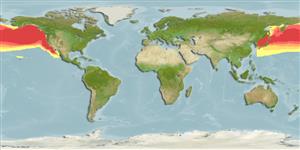分類 / Names
共通名の | 類義語 | Catalog of Fishes(部類, 種) | ITIS | CoL | WoRMS | Cloffa
Environment: milieu / climate zone / depth range / distribution range
生態学
海 深海浮遊性; 深さの範囲 16 - 1267 m (Ref. 96339). Deep-water; 66°N - 21°N, 128°E - 109°W
North Pacific: Bering Sea to Japan, and Baja California, Mexico.
サイズ / 重さ / 年齢
Maturity: Lm ? range ? - ? cm
Max length : 15.0 cm TL オス/雌雄の選別がない; (Ref. 87380)
背面の脊椎 (合計) : 0; 背鰭 (合計) : 11; 肛門の骨: 0; 臀鰭: 14. This species' most striking feature is the transparent, cowl-like shield that covers the top of the head, and its prominent tubular eyes within. The shield is a tough, flexible integument that attaches to the dorsal and medial scales behind the head, and to the broad, transparent subocular bones that protect the eyes laterally. The fluid-field chamber found beneath the shield surrounds and protects the eyes with vivid green lenses. The tubular eyes of this fish can look forward as well as upward (with maximum arc of rotation observed about 75 degrees). The morphology of the eyes apparently allow at least two feeding modes: (1) with body horizontal and with eyes directed upward, it can spot food against lighted waters above, it pivots its body to bring the mouth up for ingestion while eyes are locked on target, rotating from dorsal to rostral relative to the body; and (2) with body horizontal, eyes rotate dorsal to rostral while tracking the path of descending food until it reaches the level of the mouth (Ref. 87379). Adipose at the base of the caudal peduncle (Ref. 6885). Adults dark brown (Ref. 6885).
A solitary fish, occurring at lower mesopelagic depths beneath temperate and subarctic waters. Caught by midwater trawl nets in areas with bottom depths of 1600-3600 m. Stomach contents include cnidarian remains, however, its visceral anatomy suggests diets of mixed zooplankton, including both gelatinous and crustacean prey and siphonophore tentacles and nematocysts (Ref. 87379). Uncommon species (Ref. 6885). Oviparous, with planktonic larvae (Ref. 35626). A photo of a 15 cm long fish shown at http://www.newscientist.com/gallery/new-species/9.
Life cycle and mating behavior
成熟 | 繁殖 | 放精 | 卵 | 生産力 | 幼生
Eschmeyer, W.N., E.S. Herald and H. Hammann, 1983. A field guide to Pacific coast fishes of North America. Boston (MA, USA): Houghton Mifflin Company. xii+336 p. (Ref. 2850)
IUCNのレッドリストの状況は (Ref. 130435: Version 2024-2)
Human uses
水産業:
用具
特記事項
XMLをダウンロードして下さい
インターネットの情報源
Estimates based on models
Preferred temperature (Ref.
123201): 0.6 - 6.8, mean 3.7 °C (based on 175 cells).
Phylogenetic diversity index (Ref.
82804): PD
50 = 1.0000 [Uniqueness, from 0.5 = low to 2.0 = high].
Bayesian length-weight: a=0.01122 (0.00514 - 0.02450), b=3.04 (2.87 - 3.21), in cm total length, based on all LWR estimates for this body shape (Ref.
93245).
栄養段階 (Ref.
69278): 3.6 ±0.1 se; based on size and trophs of closest relatives
回復力 (Ref.
120179): 高い, 15か月以下の倍増期間の最小個体群 (Preliminary K or Fecundity.).
Fishing Vulnerability (Ref.
59153): Low vulnerability (10 of 100).
